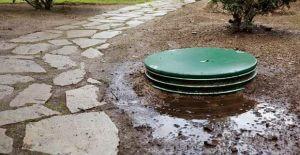Understanding septic tank sizes
A septic tank can be a great addition to a property, usually below the ground in a yard or garden.
As a small waste management system, it can deal with sewage and wastewater from rural homes, stopping it from being sent to the local treatment plant.
There are many benefits to installing a septic tank.
For example, as septic tanks recycle water using a natural filtration system, they are incredibly environment-friendly. No chemicals are used as waste is broken down by naturally-occurring bacteria which is separated and then clarified. Afterwards, water is recycled and released back into its surroundings.
Septic tanks are also cost-effective, and a great alternative to installing an entirely new pipe system.
In this sense, it permits households to dispose of their wastewater without having to rely on commercial sewage companies. They are also low maintenance. Indeed, looked after well, they can last for decades without needing to be replaced.
However, for those thinking about installing septic tanks and would benefit from reading a septic tank size guide, there are rules that need to be followed.
Therefore, it’s useful to follow this septic tank sizing guide learn more about septic tank dimensions.
What is the standard size of septic tank?
There is a lot of uncertainty around the concept of the standard size of a septic tank. For that reason, it’s important to get clarification.
According to septic tank size requirements, the standard septic tank size for a residential septic tank is 4.5 feet wide, eight feet long, and six feet high.
In terms of volume, the majority of septic tanks have a capacity of between 1,000 and 1,500 gallons. However, there have been septic tanks made for domestic properties that have a capacity of as little as 2,700 litres (around 600 gallons)
This standard capacity is designed to accommodate the wastewater requirements of an average household.
Of course, dimensions change according to the type of property, specific requirements, and local regulations.
As you can appreciate already, there are several factors influencing septic tank sizing.
How do I work out the size of my septic tank?
Septic system tank sizes can be directly correlated to the functionality of a septic tank.
It’s important to work out the size of your septic tank to comply with the relevant building regulations and to ensure it runs effectively in the long term.
For those wondering how to calculate septic tank size, and searching ‘how do i find the size of my septic tank’ online seeking help, there are numerous factors to consider.
To work out the size of your septic tank, you will need to consider the number of bedrooms in your home.
As a benchmark, a home with one to three bedrooms should be sized for five people and typically require a 1,000-gallon tank, while a home with four bedrooms should be sized for six people and the tank will need to be bigger.
The volume of water used by a household will also need to be considered. This can be worked out by multiplying the maximum number of people occupying the property by 150 litres, which should give you a figure for the maximum flow per day.
Once this figure is determined, 2,000 litres can be added. This will give you an estimate of the amount of matter that your septic tank will be able to hold.
A thorough check of the property will also need to be conducted to determine its size as well as the type of soil; both of these factors potentially impacting the size of your septic tank.
Keep in mind that there are also local regulations pertaining to septic tanks, and there may be specific requirements for the size of yours.
For a more accurate estimate tailored to your specific needs, consulting a professional and asking them to conduct an assessment of your property is highly recommended.
Does septic tank size matter?
Many people thinking about whether to install a septic tank falsely believe the size of a septic tank has no relevance to its efficiency.
However, the size of a septic tank does matter and many things can do wrong if a septic tank is not the correct size.
First, the size of the tank needs to be big enough to contain and treat the wastewater coming from your household.
If your septic tank is too small, the water that is produced could be high in suspended solids which can potentially block your soakaway. This can lead to system failure as the tank will be unable to deal with the wastewater appropriately. Not only does this mean that the septic tank won’t be operating effectively, but it can also be a costly process to correct.
On top of this, wastewater that isn’t treated correctly can contaminate the local environment and surroundings, including groundwater.
On the other hand, oversizing a tank might mean that it can also become ineffective at coping with the wastewater.
Therefore, it’s crucial to strike the right balance when it comes to sizing a septic tank to guarantee optimal performance and to avoid potentially expensive reparations in the future.
A good way to ensure that your septic tank is appropriately sized is by consulting with a team of professionals such as OMDI who can give you relevant guidance on sizing a septic tank.
How do you know if your septic tank is big enough?
Recognising whether your septic tank is accurately sized involves paying close attention to signs of trouble. In fact, there are several signs that may alert you to the fact that a septic tank may not be big enough.
First, if more than one drain is unable to drain at a normal rate, it’s likely that your septic tank is full. If your sewage is not being drained correctly, because the tank isn’t big enough, there is a chance that this will go back up into the house.
If you find that there are pools of water leaking in your lawn in the area where your septic tank is placed, your septic tank may not be big enough to host the contents of the tank. This could also be a sign that it needs to be emptied.
If you notice the grass around your septic tank has stayed the same and has not begun to change colour, it’s a good sign that your septic tank is big enough as a septic tank that is full will begin to change the colour of the grass around it.
On top of this, if foul odours are emerging from your septic tanks, this should be a cause for concern. Ensuring regular maintenance of the septic tank as well as conducting frequent inspections is a great way to identify these issues early.
However, if these problems persist and you are growing concerned about the performance of your septic tank, it’s best to consult a professional in the field of wastewater drainage who will be able to assess whether your tank meets the demands and requirements of your household.
Is a bigger septic tank better?
Many people who ask themselves ‘what size septic tank do i need’ believe that getting a bigger septic tank is better than a smaller one. However, this myth isn’t necessarily true.
When considering installing a septic tank, it’s worth noting that every situation is different. Therefore, a bigger septic tank mightn’t be better in every case.
The size of the septic tank should align with the requirements of a household any other legal and regulatory conditions.
For example, installing a bigger septic tank where there is no need to do so could mean that the tank may not function properly as it will not have the right flow of wastewater.
Although bigger septic tanks have more water and tend to be equipped with reinforced sides that prevent leakage, if the tank is too big, this means that it cannot perform correctly.
While larger tanks technically have more storage capacity, it may not be the most fitting solution for every household. This is because if a family doesn’t generate enough wastewater to fill a bigger tank, this could lead to inefficient waste breakdown, which creates even more problems as a result.
As there are various local rules and regulations with regard to septic tank sizes, sometimes a bigger septic tank may conflict with these local regulations.
In terms of cost, bigger tanks may also not be better as they can take up more space in your property and can be more costly to install and maintain.
What happens if a septic tank is too big?
Many people who want to install a septic tank wonder if the septic tank size in the UK is too big for their own property and specific requirements. In many cases, having an oversized septic tank can actually be problematic, especially in the long term.
For example, if a septic tank is too big, there may not be enough liquid to support the required bacteria such as anaerobic bacteria which are responsible for breaking down solid waste. This can result in inefficient waste breakdown as there is poor bacterial activity.
Of course, a septic tank that is too big will not be as effective as a regularly sized septic tank. This can cause a range of problems including clogs and backups in the system. On top of this, oversized septic tanks can be the culprit in releasing partially untreated effluent into the drain field, posing a risk of environmental contamination.
Remember that it’s highly recommended to choose an appropriate septic tank size based on factors such as the quantity of people living in the house, the soil type, and wastewater production.
By selecting the appropriate septic tank size, as well as conducting regular inspections and adjustments, you should be able to maintain a healthy septic system and prevent future system issues.
What is the smallest septic tank you can buy?
The smallest septic tank available to purchase varies but they are available for those with smaller households as the minimum size of a septic tank is a 500-gallon tank.
However, in some regions, the smallest tank you can buy is 750-gallon tank, which will accommodate one to two bedrooms.
Of course, the size of your septic tank also depends on where you are placing it.
For example, a domestic property is typically around 2,700 litres. Furthermore, local regulations may have specific requirements for septic tank size.
At OMDI, we believe it’s always advisable to consult with professionals when sizing a septic tank.
Our years of experience in the field of off-mains drainage is exemplified in our extensive repertoire of installations for commercial and domestic properties throughout the U.K.
We can provide you with information and advice on septic tank size requirements that are necessary to meet relevant standards and regulations as well as septic tanks that are bespoke to ensure optimum performance.
Our know-how enables us to devise systems that efficiently dispose of liquid waste while complying with relevant building regulations for either commercial or domestic premises.
Our methods entail considering the size of the property and its estimated usage because we believe that incorrectly sizing the tank can lead to problems caused by overloading the system.
We also consider the distance of a tank from buildings, structures, and property boundaries because each site has a minimum distance that must be adhered to comply with wastewater legislation.
So, why not make contact with us via our contact form or give us a call on 01977 800 418 to start a conversation.





